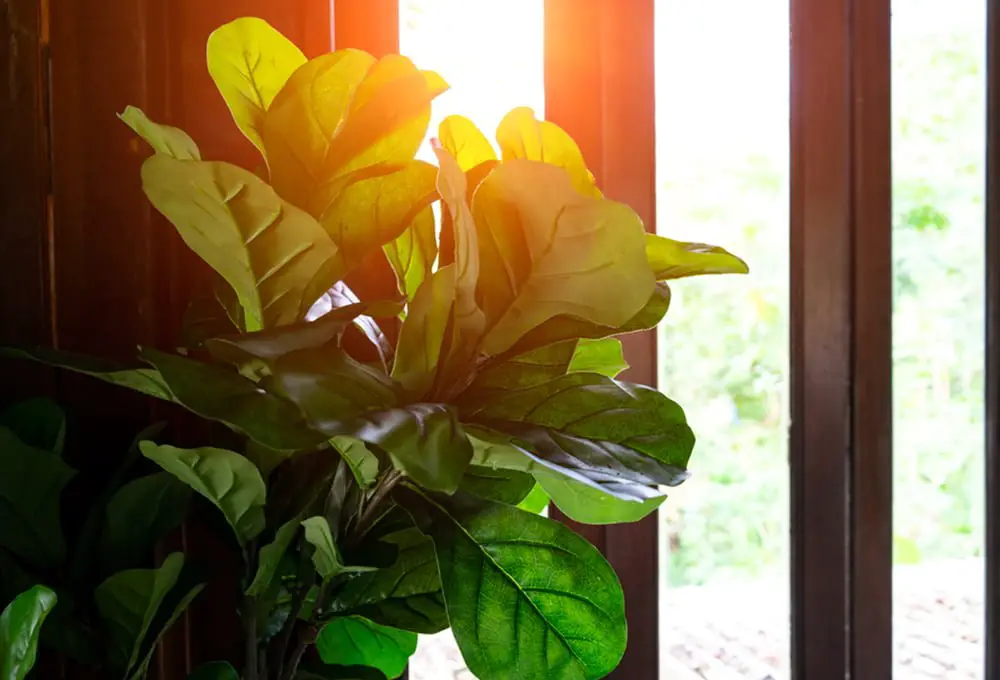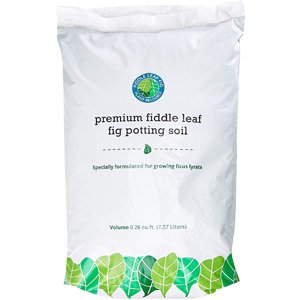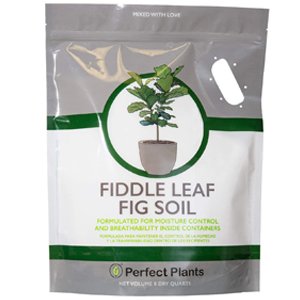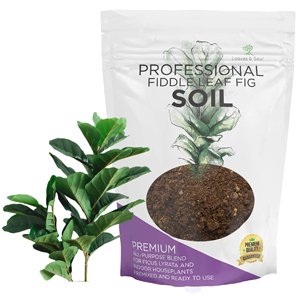
Indoor plants, such as the fiddle fig (Ficus lyrata), have gained tremendous popularity due to their aesthetic appeal and ability to bring nature indoors. However, for these plants to flourish and maintain their vibrant green foliage, providing the right growing conditions is essential. One crucial aspect is the selection and preparation of the soil. In this article, we delve into the world of soil and explore how to create the perfect medium for your fiddle fig plant.
Table of Contents
Understanding the Fiddle Fig Plant
The fiddle fig plant, native to western Africa, is known for its large, glossy, violin-shaped leaves, making it a striking addition to any space. While it is relatively hardy, providing optimal soil conditions is vital for its overall health and growth. These plants prefer well-draining soil that mimics their natural habitat and allows water to pass through, preventing root rot.
Signs you need new soil for your Fiddle Leaf Fig Tree include:
- Drooping leaves: This can be a sign that your plant has too much or not enough water, which can happen if your soil mix does not contain minerals that contribute to good drainage, or that barely holds any water.
- Falling leaves: Falling leaves are an indicator of root rot. Root rot commonly happens when you use a poorly-draining soil mix that leads to your plant sitting in water, and Fiddle Leaf Fig Trees hate sitting in water.
- Brown spots: This is the most common problem amongst Fiddle Leaf Fig plants, which is also caused by overwatering. Even if you’re only overwatering your plant a little, if you’re using poorly-draining soil, that margin for error becomes smaller and you put your Fiddle Leaf Fig plant at higher risk.
The Importance of Soil for Fiddle Fig Plants
Soil is not just a medium for plant anchorage; it plays a crucial role in providing essential nutrients, moisture, and oxygen to the roots. Optimal soil conditions encourage healthy root development, nutrient absorption, and microbial activity, fostering overall plant growth and resilience. When it comes to fiddle fig plants, the right soil composition directly impacts their ability to thrive.
Choosing the Right Soil
The ideal soil composition for fiddle fig plants is light, well-draining, and nutrient-rich. A combination of peat moss, perlite, and organic matter is often recommended. Peat moss provides moisture retention, while perlite improves drainage and aeration. Organic matter, such as compost or well-rotted manure, adds essential nutrients and enhances soil structure.
Creating a Soil Mix for Fiddle Fig Plants
To create a suitable soil mix for your fiddle fig plant, follow these steps:
- Select a well-draining pot: Choose a pot with drainage holes to allow excess water to escape. This prevents waterlogging and root rot.
- Prepare the soil mix: Combine equal parts peat moss and perlite in a container. Peat moss retains moisture, while perlite improves drainage.
- Add organic matter: Mix in a small amount of well-rotted compost or manure to enrich the soil with nutrients and enhance its structure.
- Check the soil pH: Fiddle fig plants prefer a slightly acidic to neutral soil pH range of 6.0-7.0. Test the pH using a soil testing kit and adjust if necessary.
- Repotting: If your fiddle fig plant has outgrown its current pot or shows signs of root bound, carefully repot it in the new soil mix, ensuring the roots are adequately covered but not buried too deeply.
Types of Soil Mixes
That said, we listed some soil mixes to get you started. Here are some of the best soils for Fiddle Leaf Fig Trees to give your house plant the nutrients it needs.
1. Premium Fiddle Leaf Fig Tree Potting Soil – Perfect for Indoor Plants
This well-draining soil from the Fiddle Leaf Fig Plant Food Store is especially for your large leafy houseplant. With organic aged bark, coco coir, and perlite, this soil maintains an optimal balance of water and air for your Fiddle Leaf Fig Tree.
This soil mix perfectly balances water retention and drainage so you can worry less about overwatering and root rot. Containing a blend of nutrients including Biochar, nitrogen, and phosphorus, your plant will be sure to grow bigger and stronger thanks to this soil.
2. Fiddle Leaf Fig Soil by Perfect Plants
This soil by Perfect Plants is nutrient-rich and provides ideal drainage control for your Fiddle Leaf Fig Tree. The lightweight formula does not suffocate the roots of your plant, allowing them to grow freely. This soil is a critical blend of coconut coir, pine bark, perlite, and sand to provide your fig with the moisture and nutrition it needs. This soil is enhanced with Fiddle Leaf Fig Food, too. It feeds your plant for six months, so it will put out more lush, green foliage by releasing fertilizer for six months.
3. Fiddle Leaf Fig House Plant Soil Premium All Purpose Blend
This pre-mixed Fiddle Leaf Fig Soil blend from Leaves and Soul will support your plant’s growth by giving it the nourishing environment it needs to thrive. This soil mix prevents overwatering by holding enough water to meet the plant’s needs and allowing excess water to drain. It also maximizes fertilizer absorption and nutrient uptake while providing the aeration that the roots need to grow. This soil is suitable for any Fiddle Leaf Fig plant, and Leaves and Soul also offer specialized soil for other plants, such as Bonsai plants and orchids.
Soil Maintenance for Fiddle Fig Plants
Proper soil maintenance is essential for the long-term health of your fiddle fig plant. Consider the following guidelines:
- Watering: Provide enough water to keep the soil lightly moist but not soggy. Allow the top inch of soil to dry out between watering to prevent overwatering, which can lead to root rot.
- Fertilisation: Fiddle fig plants benefit from regular fertilisation during the growing season (spring and summer). Use a balanced, water-soluble fertilizer diluted to half strength every two to four weeks.
- Soil Moisture and Humidity: Fiddle fig plants thrive in moderate humidity levels. Use a humidifier or place a tray of water near the plant to increase humidity. Avoid placing the plant near drafts or heating/cooling vents.
- Soil Inspection: Periodically check the soil for signs of compacting or waterlogging. If the soil feels excessively compacted or water is not draining properly, consider repotting the plant in fresh soil to ensure proper aeration and drainage.
- Soil Amendments: Over time, the nutrients in the soil may become depleted. To replenish them, you can use organic fertilisers or compost. Apply a thin layer of compost on the soil surface or incorporate it into the top few inches of soil during the spring or early summer.
- Soil pH Monitoring: Regularly check the soil pH to ensure it remains within the optimal range of 6.0-7.0. If the pH becomes too acidic or alkaline, adjust it using appropriate soil amendments or additives recommended for indoor plants.
Pruning and Soil Replacement
As your fiddle fig plant grows, it may develop compacted roots or become root-bound. When this happens, it’s beneficial to prune the roots and replace the soil. Carefully remove the plant from its pot, trim away any circling or overcrowded roots, and replant it in fresh soil mix.
Other Care Tips for Fiddle Leaf Fig Tree Soil
Although Fiddle Leaf Fig Trees are relatively low maintenance and don’t require much attention, they can still be a little finicky to care for. Here are some additional care tips to help you make sure that your Fiddle Leaf Fig Tree will thrive.
- Fiddle Leaf Fig Trees grow big and grow quickly, so you should re-pot your plant every 1-3 years. Otherwise, the roots can become clogged up in the container. The best time to re-pot is in the spring, and don’t forget to change out the soil to avoid any issues with compaction and disease.
- Although your Fiddle Leaf Fig Tree will want to grow to be quite large, you can prune your tree to your desired shape and fit.
- Try to promote moderate air circulation around your Fiddle Leaf Fig plant to prevent fungus diseases and other problems. A ceiling fan works great for this, but avoid cold, drafty air such as that from an A/C, which can cause your plant to droop and the leaves to turn brown.
- Keep your Fiddle Leaf Fig out of direct sunlight. Direct sunlight may burn the leaves. If your plant starts moving towards the sunlight in an odd shape, rotate the pot to keep growing habits even.
- Your Fiddle Leaf Fig Tree’s leaves are susceptible to dust. Wipe the leaves off from time to time, as the dust can block your plant from absorbing enough sunlight.
Conclusion
The soil in which a fiddle fig plant grows plays a significant role in its overall health and vitality. Providing the right soil conditions ensures optimal root development, nutrient uptake, and water drainage. By selecting a well-draining soil mix that incorporates peat moss, perlite, and organic matter, you create an ideal environment for your fiddle fig plant to thrive. Regular maintenance, including proper watering, fertilization, and monitoring of soil moisture, pH, and compaction, will help sustain the plant’s health and prevent issues such as root rot. Remember, the key to a flourishing fiddle fig plant lies in the quality and care of its soil, so invest time and attention in creating and maintaining the perfect soil medium for this magnificent indoor plant.



